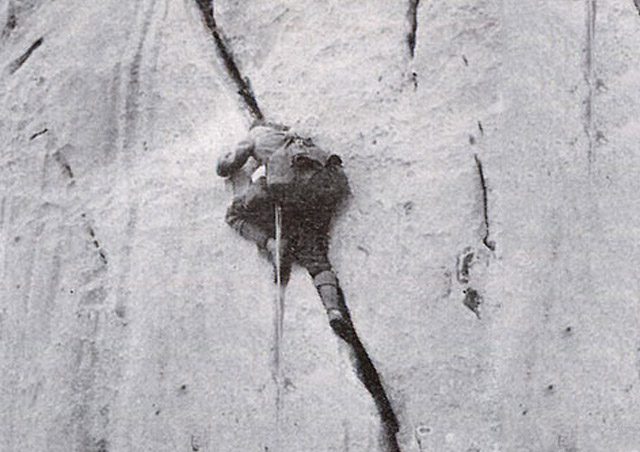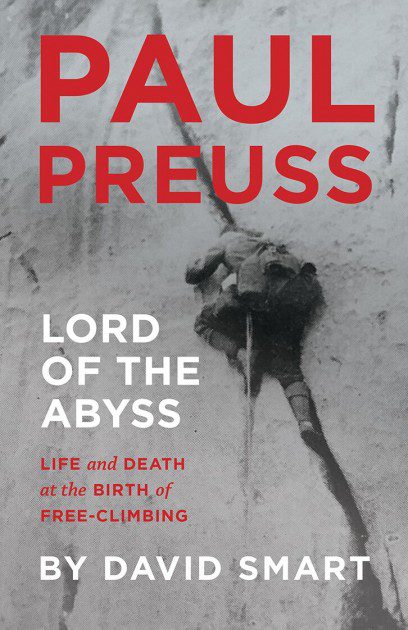Words with Author of ‘Paul Preuss: Life and Death at the Birth of Free-Climbing’
Preuss was one of the most bold free-soloists of all time

David Smart is the editorial director of Gripped Publishing and founding editor of four magazines, including Gripped, Canada’s Climbing Magazine. He is the author of five guidebooks, as well as two novels and the memoir A Youth Wasted Climbing. Smart lives in Toronto and makes regular trips to the Canadian Rockies.
His most recent book is Paul Preuss: Life and Death at the Birth of Free-Climbing, which chronicles the life of one of the world’s first cutting-edge free-climbers. Preuss was a bold free-soloist who left a lasting impression on the sport.
Paul Preuss: Life and Death at the Birth of Free-Climbing is being published in July 2019 by Rocky Mountain Books. For more information and to pre-order visit here.
Words with David Smart
Who is Paul Preuss and what are two important contributions he made to climbing? Paul Preuss was an Austrian climber who died in 1913 at the age of 27. He made over a thousand climbs in the Alps, mostly in the eastern Alps. One important climb was his free-solo first ascent of the East Face of the Campanile Basso, a wall so steep and smooth that most people considered it impossible, after which he downclimbed his route.
He had also free-soloed the West Face of the Totenkirchl, considered the hardest rock climb in the Alps at the time, a few days before. He made early inroads on the first ascent of the Peuterey Ridge in the Mont-Blanc range as well, adding a new route to the Aiguille Blanche in the process.
I would say that his greatest contribution, however, was in the discussion later called the Piton Controversy, which was really about the definition and soul of free-climbing. He represented the total ethical core of climbing. He allowed no pitons and no rope tension or rappelling and even looked askance at clean protection (slings over rock features back then).
Other climbers contributed insights into the use of ropes and pitons or the importance of athleticism and the search for difficulty that were tempered by the knowledge that among them was a brilliant climber who unflinchingly and cheerfully embraced the ideal of eschewing all of these things. Without him, modern free climbing might not have developed as it did.
Why did you choose to write about him? There was no English book about him, yet many climbers from the first half of the twentieth century, including George Mallory and Emilio Comici considered him the greatest climber who ever lived. People loved him, even when they disagreed with him. He was so driven and committed; he had a very complex personality.
He did not come from a family of climbers and in some ways was self-taught. As a child he had polio and was temporarily paralyzed. He grew up in an environment of learning and culture and knew Brahms and Schumann and climbed with the Freuds. He craved bourgeois respectability. He was one of the first climbers to make a living giving presentations. He also grew up Jewish and converted to Christianity. There is a fable about assimilation in there. Then there’s his claim to have been a PhD… he’s a very compelling figure.

How did you go about researching Preuss? One of the fascinating things about Preuss is how his historians got to work shaping his legend right away; he has been written in and out of history according to the perceived needs of the moment.
Because he was Jewish he was often left out of histories between the World Wars. Later, because he died free-soloing the Mandlkogel in pursuit of the strictest ethics, he was avoided by writers who were actually trying to make traditional ethics winsome. Emmy Eisenberg-Brioschi, Preuss’s girlfriend, gave most of his correspondence and route books to an interesting Italian historian with a compromised climbing record named Severino Casara. Casara wrote an exhaustive but not very objective book about Preuss in Italian.
Most of these papers are now only available in Casara’s reproductions, although some correspondence survived and is in the collections of the Angellini Library in Belluno in Italy and the archives of the German Alpine Club in Munich. Reinhold Messner published an essential collection of Preuss’s most important published essays, along with other reflections on his role.
His climbing partners, including some of the best of his generation – Geoffery Winthrop-Young, Hans Dülfer, Tita Piaz – often recorded their experiences with him, since he was so charismatic. No one climbed with him without wanting to tell a story afterwards. He and his friends also used some of the first small handheld cameras taken on rock climbs.
While these would not win any awards for modern climbing photography, they contain a lot of information, often unwittingly, about how Preuss climbed and how his friends reacted. I also researched the context of climbing, skiing, religion, antisemitism and other relevant subjects in the places he lived.
You’re coming off writing two fictional books about climbing around the same time period (Above the Reich and Cinema Vertigo), what was it like writing about someone who had real influences on the sport of climbing? Fiction is just another tool for looking at history. It can be very effective. In any case, professional historians are always accusing each other of writing fiction unawares.
I felt that this time I wanted to really provide a book that presented Preuss in as much detail as I could, since it was the first English book on one of the most important climbers in history.
What do you want readers to take away from Preuss’s life? To paraphrase his friend Tita Piaz, “to partake of the mighty fantasies of his youth, his great days, hard victories, the unrealized, devious possibilities still within him and his insane thirst for altitude.”
And, while they’re at it, learn more about climbing in Paul’s era and how it shaped the sport.



